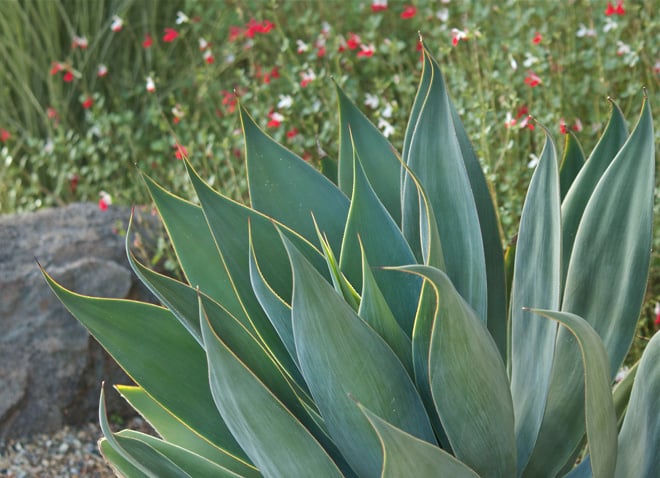

Contributor

This is the first in a 4-part series we’ve named Planting the New California Garden. Throughout 2017 we’ll be highlighting the work of APLD designers to illustrate practical water-use data beautifully brought to life in a finished landscape. Our Planting the New California Garden series is funded in part by a grant from the Saratoga Horticultural Research Foundation.
Designer Linda Middleton (APLD) refreshed a dated landscape for a client in Concord, California. Janet’s front yard was once filled with juniper, wintercreeper, fortnight lilies, and a few sad flaxes. The back yard was a hodgepodge of iceberg roses, lavender, nandina, melaleucas, flaxes and sedums; large plants placed at the patio’s edge hid the rest of the garden from view and there was little color in the tired landscape. Janet regularly volunteers at the world-renown Ruth Bancroft Garden, which inspired her to incorporate more succulents into her new landscape. The hardscape and an existing arbor in the original garden were tastefully designed and installed but the plantings needed help.
Linda’s design called for removing the overgrown plantings hemming in the backyard patio and replacing them with artful compositions selected for color and texture in foliage as well as bloom. Once tired and disjointed, today the new landscape brims with energy and pleasing water-wise compositions that complement the existing hardscape and provide garden interest throughout the year.

and Sedum spectabile ‘Autumn Joy’. Photo: Jude Parkinson-Morgan
The California Department of Water developed the Water Use Classification of Landscape Species (WUCOLS) project in response to the relative lack of research-based information classifying plants by irrigation need. The first edition, completed in 1992, compiled field trial results and observations contributed by regional evaluation committees made up of knowledgeable horticulturists from throughout California. Now in its fourth edition, WUCOLS IV evaluates water use needs for more than 3,500 commonly available California landscape plants. The information-rich database is freely available online and is intended to serve as a reliable resource for anyone involved with planning, designing, and managing landscapes.

Terralinda Design
Linda Middleton is president and principal designer with Terralinda Design, where she works closely with clients and industry professionals to provide creative solutions and designs for beautiful, sustainable landscapes. She’s recently launched a residential landscape maintenance division to ensure that her gardens thrive and problems are resolved promptly. As president of the Bay Area district of the California chapter of the Association of Professional Landscape Designers, Linda keeps up with industry trends and environmental issues. Her background includes a BS in Mathmatics, a AA in both Landscape Architecture and Landscape Horticulture, dual certification in Bay Friendly Design and Maintenance, as well as certifications in fire-scaping from the Diablo Fire Safe Council, G3 Greens Garden Group, and Qualified Water Efficient Landscaper (QWEL)
Contact Linda here.
Share:
Social Media
Garden Futurist Podcast
Most Popular
Videos
Topics
Related Posts

Low Maintenance Gardens – Better for Pollinators and People
Autumn 2022 “I come out every day. It’s therapy, my meditation.” Janet’s young garden transformed from overgrown, invasive plants to mostly natives. The dailiness of

Invasive Plants Are Still Being Sold: Preventing Noxious Weeds in Your Landscape
Autumn 2022 With so many beautiful ornamental plant species and cultivars throughout California and the Pacific Northwest, how do you decide which ones to include

Garden Design in Steppe with Transforming Landscapes with Garden Futurist Emmanuel Didier
Summer 2022 Listen to full Garden Futurist: Episode XVII podcast here. Emmanuel Didier, Principal and Creative Director at Didier Design Studio is a leading figure

Seslerias: Versatile Groundcover Meadow Grasses
Summer 2022 Without question, the most beautiful and versatile of all the groundcover meadow grasses are the moor grasses (Sesleria). Moor grasses tick off all










Responses